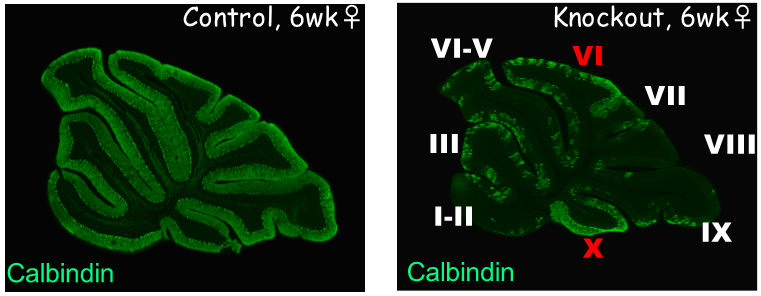 |
June 2017 Mouse of the Month |
A tool for understanding endogenous sphingolipid synthesis
B6;129(FVB)-Sptlc2<tm1.1Yhir> (RBRC09802)Courtesy of Yoshio Hirabayashi, Ph.D. Progressive and selective Purkinje cell degeneration in conditional Sptlc2 knockout mouse. Sagittal sections were immunostained with anti-calbindin. |
|
Sphingolipids are a class of lipids containing a backbone of hydrophobic chain of ceramide. They are ubiquitously distributed in biological membranes and play important roles in signal transmission, vesicular transport, cell homeostasis, and cell-cell interaction. Sphingolipids are abundant in the CNS tissues and the lipid synthesis is essential for dendritic development and survival of cerebellar Purkinje neurons [1]. Serine palmitoyltransferase (SPT, EC 2.3.1.50) is the enzyme which catalyzes the first step of the sphingolipid biosynthesis. SPT consists mainly of long chain base subunit 1 (SPTLC1) and 2/3. SPTLC2 encoded by the Sptlc2 is essential component for activities. In humans, mutations in the SPTLC2 cause hereditary sensory and autonomic neuropathy type I [2]. The complete knockout (KO) of Sptlc2 results in a fetal lethal phenotype. Thus, the Sptlc2 floxed mice were developed to study physiological roles of sphingolipid synthesis [3]. Figure shows selective cell death of cerebellar Purkinje neurons in the specific KO mouse (Osuka et al., unpublished results). Recent studies by Summers group demonstrated that sphingolipid plays a critical role in adipocyte physiology [4]. Thus, the cKO mice are useful tools to elucidate in vivo functions of sphingolipid synthesis in central and peripheral tissues. |
| Depositor | : | Yoshio Hirabayashi, Ph.D. Laboratory for Molecular Membrane Neuroscience RIKEN Brain Science Institute |
|
| Strain name | : | B6;129(FVB)-Sptlc2<tm1.1Yhir> | |
| RBRC No. | : | RBRC09802 | |
| References | : | [1] | Hirabayashi Y, Furuya S. Roles of l-serine and sphingolipid synthesis in brain development and neuronal survival. Prog Lipid Res.; 47(3):188-203, 2008. |
| [2] | Rotthier A, Auer-Grumbach M, Janssens K, Baets J, Penno A, Almeida-Souza L, Van Hoof K, Jacobs A, De Vriendt E, Schlotter-Weigel B, Löscher W, Vondráček P, Seeman P, De Jonghe P, Van Dijck P, Jordanova A, Hornemann T, Timmerman V. Mutations in the SPTLC2 subunit of serine palmitoyltransferase cause hereditary sensory and autonomic neuropathy type I. Am J Hum Genet.; 87(4):513-22, 2010. | ||
| [3] | Ohta E, Ohira T, Matsue K, Ikeda Y, Fujii K, Ohwaki K, Osuka S, Hirabayashi Y, Sasaki M. Analysis of development of lesions in mice with serine palmitoyltransferase (SPT) deficiency -Sptlc2 conditional knockout mice-. Exp Anim.; 58(5):515-24, 2009. | ||
| [4] | Chaurasia B, Kaddai VA, Lancaster GI, Henstridge DC, Sriram S, Galam DL, Gopalan V, Prakash KN, Velan SS, Bulchand S, Tsong TJ, Wang M, Siddique MM, Yuguang G, Sigmundsson K, Mellet NA, Weir JM, Meikle PJ, Bin M Yassin MS, Shabbir A, Shayman JA, Hirabayashi Y, Shiow ST, Sugii S, Summers SA. Adipocyte Ceramides Regulate Subcutaneous Adipose Browning, Inflammation, and Metabolism. Cell Metab.; 24(6):820-834, 2016. | ||
| June 2017 Contact: Shinya Ayabe, Ph.D. Experimental Animal Division, RIKEN BioResource Center All materials contained on this site may not be reproduced, distributed, displayed, published or broadcast without the prior permission of the owner of that content. |





